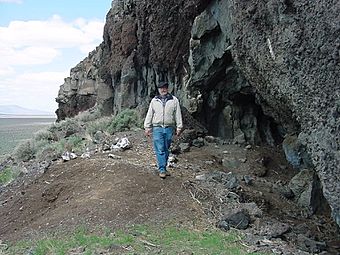Paisley Caves facts for kids
Quick facts for kids |
|
|
Paisley Five Mile Point Caves
|
|

Bill Cannon, Bureau of Land Management archaeologist, near Cave No. 5
|
|
| Location | Address restricted |
|---|---|
| Nearest city | Paisley, Oregon |
| Built | ca. 14,300 BP |
| NRHP reference No. | 14000708 |
| Added to NRHP | September 24, 2014 |
The Paisley Caves are a group of four caves in a dry area of south-central Oregon, United States. They are located north of the town of Paisley, Oregon. These caves sit in the Summer Lake basin, about 4,520 feet (1,378 meters) above sea level. They face west, carved into ancient rock formations. Long ago, huge waves from Summer Lake helped shape these caves.
One of the Paisley Caves might hold some of the oldest proof of humans living in North America. This amazing site was first explored by a scientist named Luther Cressman in the 1930s. Since 2002, new studies have found even more exciting things. Scientists have discovered the oldest DNA evidence of people living in North America here. This DNA, found in ancient human poop (called coprolites), is about 14,300 years old! Because of their important history, the Paisley Caves were added to the National Register of Historic Places in 2014.
Contents
Discoveries at Paisley Caves
Since 2002, a team from the University of Oregon has been carefully studying the Paisley Caves. They are looking for artifacts (old objects) from a time before the well-known Clovis people. In the summer of 2007, they found the oldest human DNA ever discovered in the Americas. This DNA came from several samples of coprolite (fossilized poop) found in the caves.
What the Coprolites Tell Us
The ancient coprolites were found in Paisley Five Mile Point Cave. They were located about 7 feet (2 meters) below the ground, near a small fireplace made of rocks. At the same level, scientists also found many bones from birds, fish, and large animals. These included bones from extinct (no longer living) camels and horses.
Scientists used a method called Radiocarbon dating to figure out the age of these coprolites. They are between 12,750 and 14,290 years old. This suggests that people lived here even before the Clovis culture, which was once thought to be the first widespread human culture in North America. DNA tests on the coprolites show that these early people might have come from Siberia or Asia.
Avoiding Past Mistakes
In the past, some archaeological digs at other sites, and even earlier work at Paisley Caves in the 1930s, had problems with how they dug up artifacts. This made it hard to be sure about the findings. The University of Oregon team learned from these mistakes. They worked very carefully to make sure their discoveries were accurate and reliable.
The idea is that the first people came to North America by traveling down the Pacific Coast. If this is true, they would have passed through the area that is now Oregon. Besides human DNA, the team also found DNA from coyotes, foxes, and dogs (or wolves) in the caves.
Tools of Early Hunters
Later, hunting tools were found in the caves. These tools included special spear points called 'Western Stemmed points'. These points look very different from the Clovis points. This means that the people living in Paisley Caves were not using the same tools as the Clovis people. No evidence of Clovis tools was found at the site.
In 2002, another team from Oregon State University found proof of humans on the southern Oregon coast. This site, called Indian Sands, showed human presence from more than 10,000 years ago. This was over 2,000 years older than other known archaeological sites on Oregon's coast at that time. Carbon dating of artifacts there, similar to those found in Alaska and British Columbia, suggested they were about 12,000 years old.
See also
 In Spanish: Cuevas de Paisley para niños
In Spanish: Cuevas de Paisley para niños

